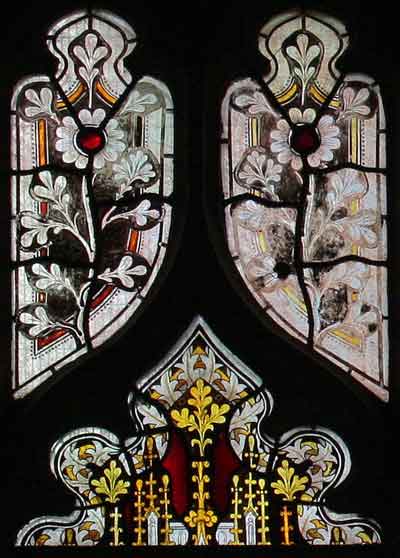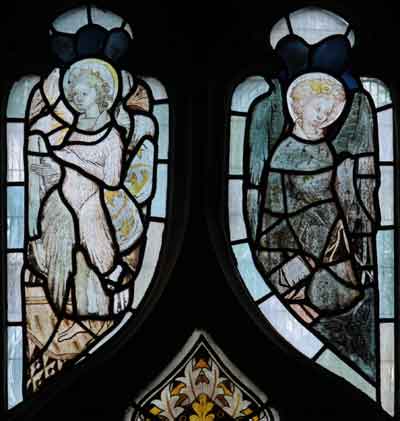

Although at a distance this red figure could easily be mistaken for a representation of a devil, it is in fact a red squirrel cracking a nut. The squirrel was the badge of the Lovell family, who have long been associated with East Harling.


15th century angels


The Annunciation : The Blessed Virgin Mary stands at a prayer desk with a kneeling archangel Gabriel. Note the Lilies a flower which represents purity and the dove descending from a cloud, a traditional symbol of the Holy Spirit

The Visitiation : The scene depicts The Blessed Virgin Mary with her mother St Elizabeth

The Nativity : Here we see The Child lying in a manger, The Blessed Virgin Mary and Joseph (who has unfortunately lost his face). The two women standing behind Mary are believed to be midwives. The legend of the presence of a midwife at he Nativity dates back to the 2nd century.

The Adoration of the Shepherds: The detail in this scene is exquisite. It includes : shepherds holding a lamb and playing on pipes; an ox and ass feeding in a manger; a stool on which is laid a ladle containing liquid and a tiny spoon

The Adoration of the Kings : The Blessed Virgin (whose head has been lost and replaced by the head of an Angel) sits, holding Jesus on her lap. The three Kings present their gifts: a cup containing coins marked with crosses, a cup with a pyramidal cover and an incense boat

This panel survives from a window illustrating the Te Deum (an early Christian hymn of praise). It is composed of three quarter length figures of angels, many of which are now incomplete

The Presentation in the Temple : Simeon holds Jesus looked upon by Mary and Joseph. The latter is holding a basket containing the customary sacrifice of two turtle doves

Jesus before the Doctors of the Law: Christ talks to the Doctors, who wear an eclectic range of outfits, looked upon by his mother.

The Marriage Feast at Cana : Christ sits at the table with the bride & groom. The man, with a long white towel hanging over his shoulder, represents the “ruler of the feast.” Note the detail including : plates holding a joint of meat and a fowl and a child pouring out wine.

Panel is made up of medieval fragments

St Mary Magdalene : In this incomplete panel Mary holds a jar of ointment in her left hand and tresses of hair in her right.

The Betrayal : Christ is embraced by Judas, surrounded by soldiers, whilst St Peter cuts off Malchus’ ear.

The Crucifixion : Christ lies dead on the cross. Mary is being supported by St John, whilst behind them is Longinus, who pierces Christ’s side with a spear. To the right are two soldiers on horseback . Note that the upper part of Christ’s figure is made from modern glass.

The Deposition : St Mary Magdalene and St John stand behind the Virgin Mary who holds the body of Christ. Instruments relating to Christ’s passion including : scourges, nails and a sponge lie around the cross. Note that the upper part of Christ’s figure is made from modern glass

The Assumption of the Blessed Virgin Mary : Mary is taken up to Heaven attended by angels, who issue from pink clouds

Sir Robert Wingfield kneels wearing his armour. Note that around his neck he wears the Yorkist collar of Suns and Roses with the lion of March hanging from it

The Resurrection : Watched upon by four soldiers Christ, holding a crossed staff, arises from the tomb

The Ascension : The Apostles and the Virgin Mary are gathered around a rock which bears the footprints of Christ. The lower part of Christ’s figure is shown below a blue cloud. The scene is overlooked by two angels

Pentecost: The Dove (representing the Holy Spirit) surrounded by blue and red clouds, descends upon the apostles and the Virgin Mary

Sir William Chamberlain kneels wearing his armour. Note that around his neck he wears the Yorkist collar of Suns and Roses with the lion of March hanging from it
This remarkably complete 15th century window has changed little since it was donated by Sir Robert Wingfield. Robert was the second husband of Anne Harling. Anne was the daughter of Sir Robert Harling and the last representative of the family. She was a considerable heiress and both in her own right, and in the name of her husbands, was largely responsible for the 15th century refurbishment of the church.
That the window survived at all is amazing. To escape the ravages of Cromwell’s troops, it was removed and hidden in the attic of East Harling Hall, the ancient home of the Lovell family. In 1736, when the manor was sold to Thomas Wright, the glass was returned to its original setting. It was again removed during the Second World War and replaced and releaded in 1947.
It is believed that the window was made over the period c1465 – c1480. Accredited to the Norwich school of glassmakers, as a collection of glass it is second only to the East window of St Peter Mancroft (Norwich). According to David King many of the designs at the two locations are the same in particular both decorative motifs and painting styles are similar. The major differences at East Harling relate to: the use of canopies, faces being more “linear and robust”, drapery being more angular whilst sceneshere tend to be more two dimensional.
To see each panel in more detail, together with an explanation of their content, place your cursor over the highlighted boxes.
As this glass is so special a supersize image is provided by clicking those panels with a green border
